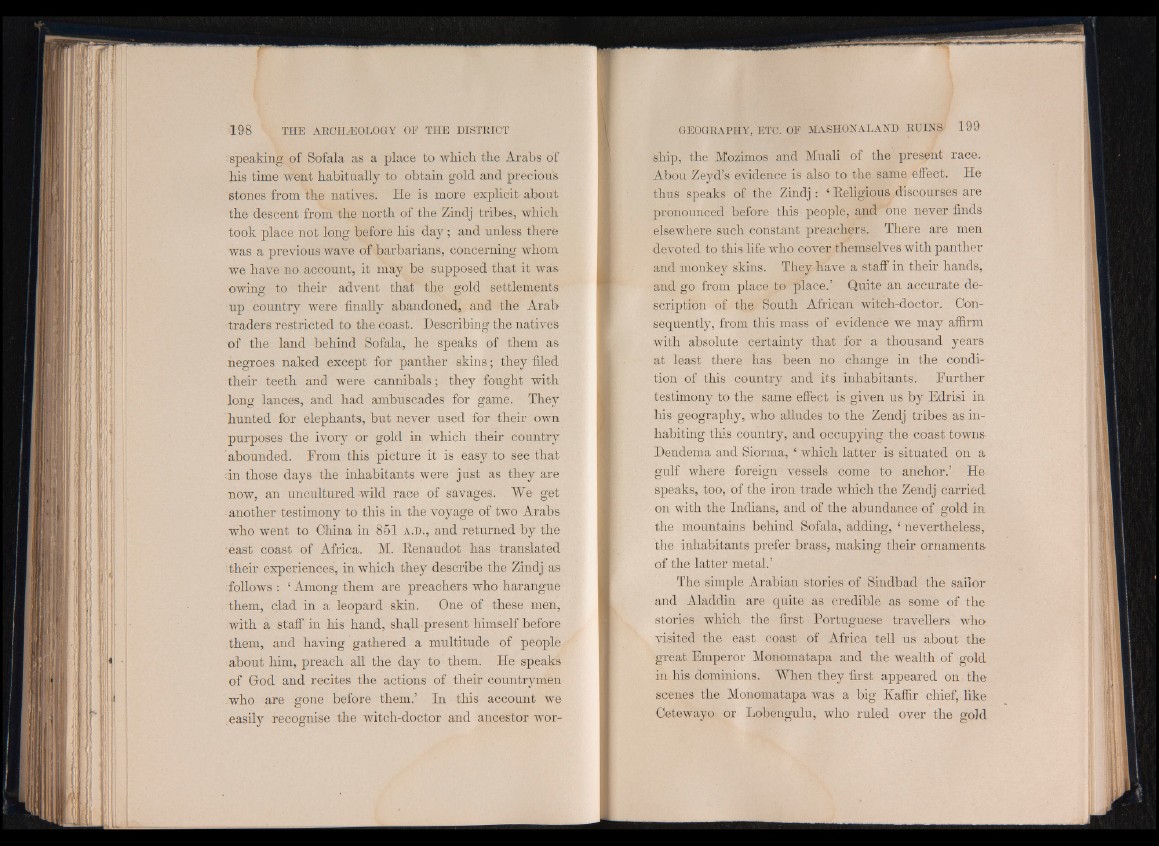
^speaking of Sofala as a place to which the Arabs of
his time went habitually to obtain gold and precious
stones from the natives. He is more explicit about
the descent from the north of the Zindj tribes, which
took place not long before his day; and unless there
was a previous wave of barbarians, concerning whom
we have no account, it may be supposed that it was
owing to their advent that the gold settlements
up country were finally abandoned, and the Arab
traders restricted to the coast. Describing the natives
of the land behind Sofala, he speaks of them as
negroes naked except for panther skins ; they filed
their teeth and were cannibals; they fought with
long lances, and had ambuscades for game. They
hunted for elephants, but never used for their own
purposes the ivory or gold in which their country
abounded. From this picture it is easy to see that
fin those days the inhabitants were just as they are
now, an uncultured wild race of savages. We get
another testimony to this in the voyage of two Arabs
who went to China in 851 a .d ., and returned by the
east coast of Africa. M. Eenaudot has translated
their experiences, in which they describe the Zindj as
follows: ‘Among them are preachers who harangue
them, clad in a leopard skin. One of these men,
with a staff in his hand, shall-present himself before
them, and having gathered a multitude of people
about him, preach all the day to them. He speaks
of God and recites the actions of their countrymen
.who are gone before them.’ Hi this account we
.easily recognise the witch-doctor and ancestor worship,
the Mozimos and Muali of the present race.
Abou Zeyd’s evidence is also to the same effect. He
thus speaks of the Zindj : ‘ Religious discourses are
pronounced before this people, and one never finds
elsewhere such constant preachers. There are men
devoted to this life who cover themselves with panther
and monkey skins. They have a staff in their hands,
and go from place to place.’ Quite an accurate description
of the South African witch-doctor. Consequently,
from this mass of evidence we may affirm
with absolute, certainty that for a thousand years
at least there has been no change in the condition
of this country and its inhabitants. Further
testimony to the same effect is given us by Edrisi in
his geography, who alludes to the Zendj tribes as inhabiting
this country, and occupying the coast towns
Dendema and Siorma, ‘ which latter is situated on a.
gulf where foreign vessels come to anchor.’ He
speaks, too, of the iron trade which the Zendj carried,
on with the Indians, and of the abundance of gold in
the mountains behind Sofala, adding, - nevertheless,
the inhabitants prefer brass, making their ornaments
of the latter metal.’
The simple Arabian stories of Sindbad the sailor
and Aladdin are quite as credible as some of the
stories which the first • Portuguese travellers who
visited the east coast of Africa tell us about the
great Emperor Monomatapa and the wealth of gold,
in his dominions. When they first appeared on the
scenes the Monomatapa was a big Kaffir chief, like
Cetewayo or Lobengulu, who ruled over the gold